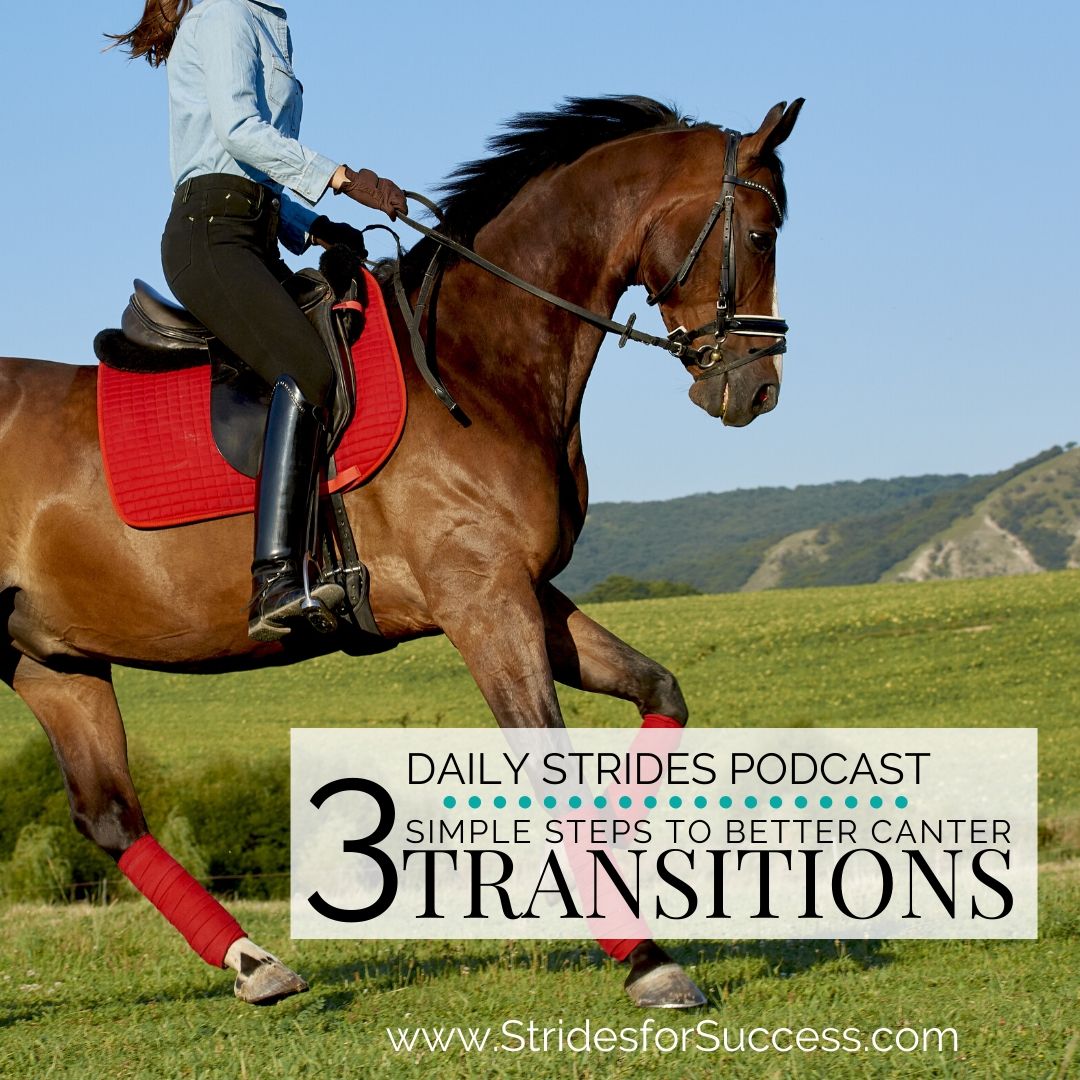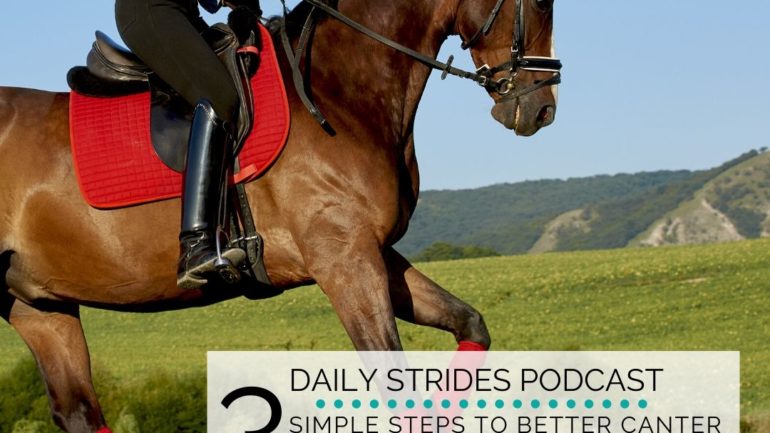
Have you ever felt that feeling? The feeling you get when you’re trotting and you ask for the canter. Rather than your horse simply striking cleanly from the trot to the canter, you experience this extremely uncomfortable and unbalanced trot. A trot that gets faster and faster until finally you almost fall into a canter. Not a great feeling, eh?!
Or perhaps, your experience of getting into canter is a little different. Maybe you feel like you are getting thrown forward every time your horse transitions to canter? Different, but equally as unpleasant!
In this episode of the Daily Strides Podcast, I want to cover a topic that I feel so many riders struggle with. Successful canter transitions. I’m going to give you 3 simple yet effective actions that you can implement today, which I guarantee you will improve your canter transitions.
And, the good news is that, I believe that you can improve this very quickly; you just need to know what to do…
1 . Plan, Plan, and Plan again!
Planning is so important. Now I know you may be thinking “Really, Lorna? I knew that”. If so, great. Are you implementing it every time you ride? When we are talking about all things canter transitions related, planning is important for both horse and rider. It allows you to set your horse up for the upcoming transition. It also gives you time to get clear on sorting your body out and making sure your body is where it needs to be.
Remember, one of your jobs, as team captain, is to set things up as well as you possibly can. Then simply allow your horse to the job you have asked him to do.
Start by choosing an exact place where you begin to sort yourself out, both physically and mentally. You then need to make sure you have your horse’s attention using your half-halt. Your half-halt basically serves to tell your horse: “Excuse me, something is going to happen soon and I need you to pay attention to me.”
It’s also important to make sure that you have established a good quality trot. An easy way to assess this is to ask the question, ‘could I jump a jump from this current trot?’. If the answer is yes, you’re golden! If not, you have a little work to do before you can ask for the canter transition.
2 . Get Out of the Way
The next part is simply to get out of your horse’s way. Remember, your job is to set it up and ask your horse to canter. That’s it! Your horse must actually transition into the canter, not you. I have seen so many riders who set it all up and then when it comes time to canter, they look like they are physically trying to canter for their horse! Often they end up leaning forward, lying on the horse’s neck or leaning over the inside shoulder, or all of the above.
Changing this starts with your basic position. Your shoulders should be above your hips. Maintaining that as you move into and through the transition is often enough to get out of your horses way.
Keeping your shoulders above your hips and not throw yourself forward or leaning to one side will make a huge difference to your canter transitions. In fact, if you can maintain a correct position, you’re already halfway to creating better canter transitions. However, I also know that often this is one of those ‘easier said than done’ things!
A simple way to keeping this fresh in your mind when you ride is to imagine a large egg. The egg is sitting on the pommel of the saddle. It is large enough that it comes all the way up to your chest. Your goal, as you prepare to and then transition into canter is not to break that egg. This will help you to maintain your position throughout your canter transitions.
-
Allow Your Horse to Canter
The third step to better canter transitions is to actually allow your horse to canter. If you are leaning forward or to one side, you aren’t really allowing your horse. You’re hindering them as they make the transition from the trot into the canter and beyond.
Your horse’s shoulders have to go somewhere when you are asking for a canter. If you’re sitting on their shoulder, you’re actually shutting down the shoulder. What I see happening with so many riders is that they plan, they set it all up and then they ask for the canter.
Unfortunately, when the horse begins to canter, it looks like they suddenly change their minds!
This can be pulling on the reins. Often the rider becomes heavy in the saddle; they hunker down. In fact, sometimes it seems that the rider is doing everything physically possible to stop that horse going forward into canter! It’s almost as if they’re thinking: “Whoa, this isn’t what I asked for!”, Even though it was.
Now believe that, most times, this is caused by something the rider is thinking or feeling, playing out physically in the transition. Whatever the cause, can you imagine how confusing it is for their horse? He has obliged his rider by doing what was asked of him and is now frantically receiving signals to stop. Would you blame the horse if over time, he decides simply not to canter at all when his rider asks?
Allowing your horse to do what it is you have asked him to do is vitally important to his training and development. It is also important for your nerves!
Imagining Successful Canter Transitions
I want you to imagine this now. You’re trotting down the long side of the arena, and you’re going to ask for a canter in the corner. You know that the first thing you need to think about is planning. So you begin half halting. This allows you to also consider whether or not it’s a good quality trot.
The half-halt is also a great place to make sure that you are in the best position to ask and then allow your horse to canter. Take the opportunity to straighten your body, through your shoulders and back. Also, straighten vertically by checking that your shoulders over your hips.
Now, choose the exact place that you want our horse to canter, and quickly think about what you need to do to communicate this to your horse.
Maybe change in sitting trot. Definitely ask for a little bit of flexion to the inside. Use your inside leg and imagine that you are filling up the outside rein. All while your inside hand is asking for that little flexion. Then move your attention to your outside leg. Imagine using it to ‘tag’ your horses outside back leg, indicating to him to ‘strike’ with that leg.
Moving with the Canter Transitions
As your horse begins to actually perform the transition, your job now becomes maintaining your own body and moving with him into the canter. Are your shoulders above your hips? What about your imaginary egg? Is it safe in front of you and are you keeping out of its space?! Consider are you carrying yourself? And carrying your hands?
Finally, as your horse takes that first, balanced step into the canter, imagine how it feels when you allow with your seat and follow him into it. Doesn’t that feel great?! Your horse is finally able to canter!
These 3 things that we’ve spoken about today are things you can continue to refine and refine. They will require you to revisit them regularly in your riding. Plan, get out of the way, and actually let the horse canter! The three steps to better canter transitions.
Happy Riding,
Lorna

